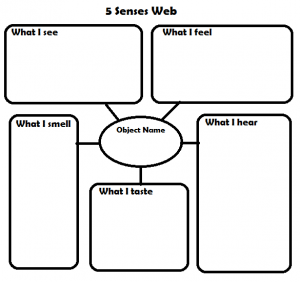Ok, what little boy doesn’t love bugs? They may not be your favorite subject, but if you are trying to help a little boy improve his speech or language skills, he’s going to love these activities! Give them a try!
Go on a Bug Hunt! (Descriptors, following directions, writing)
Help your little guy go on a bug hunt by collecting real bugs in the wild or toy/candy bugs at home. If you have nets and bug boxes, try finding some bugs outside. He will love this!! If not, you can always go buy candy bugs (like gummy worms) at the store or try to find some toy bugs. The dollar stores often have collections of plastic bugs that work well. You can hide them around the room or outside and have your child try to find and “catch” them. Once your child has collected a bug or two, have your child use all of his/her senses to describe the bug. Create a 5 Senses Web like this on a piece of paper:

Draw a small circle in the middle of the paper where you or your child will write the name of the bug. Practice saying the name with your child so he can get used to saying all of the sounds. Then, make a box for each of the 5 senses. You can label them with things like “what I see, what I hear”, etc. Have your child write something in each box that describes that sense. If your child isn’t old enough to write, you can write it for him/her. Here are some ideas of things you can include in each box if you’re struggling:
See: What color, describe its body shape, how many legs, how many eyes, what body parts, what does it do (jump, crawl, light up, eat), is it fast or slow, does it look angry or happy, how does it interact with things around it, etc.
Hear: What sound does it make, is it loud or quiet, high or low, what does it sound like, what would you like it to sound like if it doesn’t make any noise
Smell: Does it smell like anything, describe the smell, is it good or bad, is it sweet or musty like dirt, what do you wish it smelled like
Feel: Is it heavy or light, how does it feel, rough or smooth, wet or dry, prickly or soft, does it tickle if it walks on you
Taste: AAAHHH DON’T EAT THE BUGS! Ok, there I said it, I’m not endorsing bug-eating. (Even if there is an ice cream shop in my town that tried serving cicada ice cream that one time…ew) Only use this one if you chose to have candy bugs that your child can eat. If so, ask your child how it tastes, if it’s sweet or salty, if it’s chewy or crunchy, if it’s sour, etc.
After you fill in every box, you can fill out another one for a different bug and compare them.
Vocabulary Expanding Activity:
For this activity, you will need the sheets you filled out for the last activity. Get out a large piece of paper (or several pieces) and write “descriptors” at the top. Then, list all of the descriptors that you used to describe your bugs on the 5 Senses Webs. Make sure you leave room to the side of each word. Next, tell your child that you need to come up with synonyms for these words. Explain that a synonym is a word that means the same thing as a different word. You can do the first few for him/her to get started. For example, if your first word is “hard”, you could write “firm, stiff, solid” next to it. If you have trouble, look them up in a thesaurus (use the internet if you don’t have one, just type in “synonym for ____”). Don’t feel like this makes you look dumb to your kids, everyone needs help sometimes and it’s better that they know how to use resources like this. Show your child how to do it. This activity will not only expand your child’s vocabulary but it will also help show your child a tool that he can use for the rest of his life! After you finish this, hang the paper somewhere so your child can use it for reference if he needs to later (if he’s a reader) or go over it with him later as a reminder (if he’s a non-reader). You can also do this activity with antonyms and choose opposite words.
Make a Bug Book (Research, Speech, Craft, Reading)
Take pictures of bugs around the yard or get pictures of bugs from the internet for this one. Print them out and then glue each picture on its own piece of construction paper or computer paper. Then, write the bug’s name under the picture. You can also have your child write a sentence about the bug if he’s old enough. To do this, have him look up information about the bug online and write one thing about the bug that he didn’t know. Show him how to look up information on credible websites online and research subjects that interest him. After you have the book complete, have your child practice “reading” the book by saying each of the bug’s names. If your child has trouble saying the longer names, help him by breaking the words down and then piecing them back together. That would sound something like this:
Adult: Butterfly
Child: Bufai
Adult: Close, let’s try it like this- Bu
Child: Bu
Adult: Ter
Child: Ter
Adult: Fly
Child: Fly
Adult: Butter
Child: Butter
Adult: Butterfly
Child: Butterai
Adult: You’re almost there! Let’s try one more way: Fly
Child: Fly
Adult: Terfly
Child: Terfly
Adult: Butterfly
Child: Butterfly
YAY You did it!! It’s as easy as that. Practice all the bug names that way until your child can say them. For older children, have them read their books to someone else to practice their reading skills as well.
Thanks for reading! What other methods to you use to help children learn to say multi-syllabic words? Leave a comment below and let me know!
More Resources for Speech-Language Pathologists:
Looking for more therapy ideas and resources to help you provide the BEST services to your clients? Join us in The SLP Solution, our membership program for speech-language professionals! Inside the membership, you’ll find:
- Step-By-Step Guides for teaching a variety of speech/language/communication skills
- Pre-Made Worksheets and Therapy Activities for hundreds of different topics
- Training Videos for dealing with difficult disorders or problems
- Answers to Your Questions in our exclusive SLP community
- Tools and Resources to help you with your paperwork and admin tasks
- Continuing Education through our monthly webinars and webinar recordings
To join us in the full SLP Solution, or to snag a free membership, click on the button below!






CONGRATULATIONS TO YOU AND YOUR HUSBAND WITH YOU NEW LITTLE BLESSING!
Thank you for the bug ideas. Perfect timing as next week, we are doing a bug unit in summer school.
Thank you so much!! (For those of you who didn’t hear, Tom and I are pregnant!) Enjoy the bug activities!!
My name is Andra, I am SLP in Latvia , thank you very much! All activities are very interesting!
Andra
Wow! So excited that I reached Latvia! I love getting to hear about people all over the world enjoying my resources!
Thank you so much for all your exciting ideas and important information. I came across your website because I was looking for something specific but found much more. I love all your interactive and visual resources.
Susan from Australia.
Thank you so much, Susan! I’m so glad you’re enjoying the website! I love putting it together and getting to connect with people from all around the globe!
To teach multi-syllabic words I pound one fist to the other hand and count the syllables on the fisted hand as you pound. I have much success with this.
Great idea! Thanks for sharing!!
Thanks
I love speechandlanguagekids.com
I’m an (almost) speechie from South Africa and I really appreciate your enthusiasm, awesome materials and general tips on how to be the best SLT that you can be. You inspire me. Thank-you
You’re welcome!